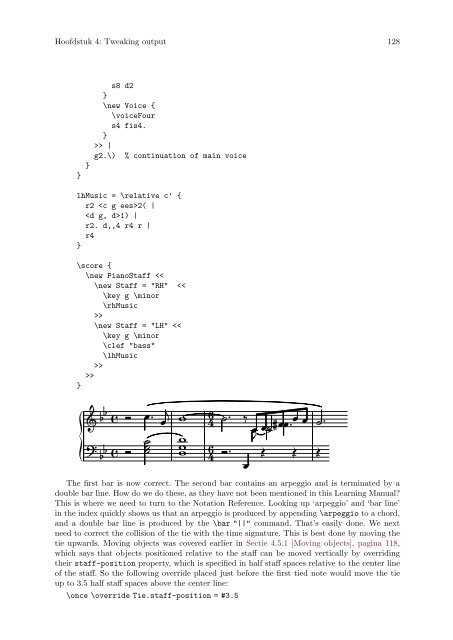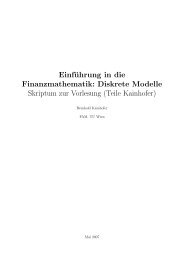LilyPond Beginnershandleiding
LilyPond Beginnershandleiding
LilyPond Beginnershandleiding
Create successful ePaper yourself
Turn your PDF publications into a flip-book with our unique Google optimized e-Paper software.
Hoofdstuk 4: Tweaking output 128<br />
s8 d2<br />
}<br />
\new Voice {<br />
\voiceFour<br />
s4 fis4.<br />
}<br />
>> |<br />
g2.\) % continuation of main voice<br />
}<br />
}<br />
lhMusic = \relative c' {<br />
r2 2( |<br />
1) |<br />
r2. d,,4 r4 r |<br />
r4<br />
}<br />
\score {<br />
\new PianoStaff <br />
\new Staff = "LH" ><br />
>><br />
}<br />
<br />
<br />
<br />
<br />
<br />
<br />
<br />
<br />
<br />
<br />
<br />
4 6<br />
4 6<br />
<br />
<br />
<br />
<br />
<br />
<br />
<br />
The first bar is now correct. The second bar contains an arpeggio and is terminated by a<br />
double bar line. How do we do these, as they have not been mentioned in this Learning Manual?<br />
This is where we need to turn to the Notation Reference. Looking up ‘arpeggio’ and ‘bar line’<br />
in the index quickly shows us that an arpeggio is produced by appending \arpeggio to a chord,<br />
and a double bar line is produced by the \bar "||" command. That’s easily done. We next<br />
need to correct the collision of the tie with the time signature. This is best done by moving the<br />
tie upwards. Moving objects was covered earlier in Sectie 4.5.1 [Moving objects], pagina 118,<br />
which says that objects positioned relative to the staff can be moved vertically by overriding<br />
their staff-position property, which is specified in half staff spaces relative to the center line<br />
of the staff. So the following override placed just before the first tied note would move the tie<br />
up to 3.5 half staff spaces above the center line:<br />
\once \override Tie.staff-position = #3.5



